
Talk about timing. Just days after Israel sent troops into Lebanon in early October, there were suddenly rumours about a mysterious seismic event that had occurred deep beneath the vast desert plain in the northern Iranian district of Semnan.
Iran, the frenzied talk went, had broken cover with an underground atomic test; its first ever. The nation’s nuclear program had somehow evaded decades of Western scrutiny and ignored non-proliferation treaties to produce a viable bomb. Iran now sat among the exclusive group of nations with the power to deploy the most fearsome of weapons, including its regional neighbours Pakistan, India and Israel.
It turned out to be a false alarm. The seismic activity was from an earthquake of 4.5 magnitude. Still, many Iranians wondered what might have been. “I’m not going to lie, I was kind of disappointed when I heard it wasn’t a nuclear test,” Ali, a 25-year-old nurse residing in Iran’s capital Tehran, told the Tehran Times.
Apparently, this is an increasingly common view in Iran in light of Israel’s operations in Gaza, Lebanon, Yemen and Syria, says the Tehran Times: “Iranians are increasingly concerned about whether their country has enough deterrence to prevent Israel from repeating these actions against Iran.”
As Israel remains locked in conflicts in Gaza and Lebanon, it is reportedly gearing up for “lethal” and “surprising” retaliation after a ballistic missile attack by Iran on October 1. Striking Iran’s nuclear facilities has been floated as one potential, if extreme, response. Iran has a sophisticated nuclear infrastructure that includes a Russian-built reactor to make electricity as well as various research facilities and stockpiles of enriched uranium, some of it refined to nearly weapons-grade.
But how close is Iran to developing nuclear warheads? Where did its nuclear program come from? And what would be the effect of an Israeli strike?
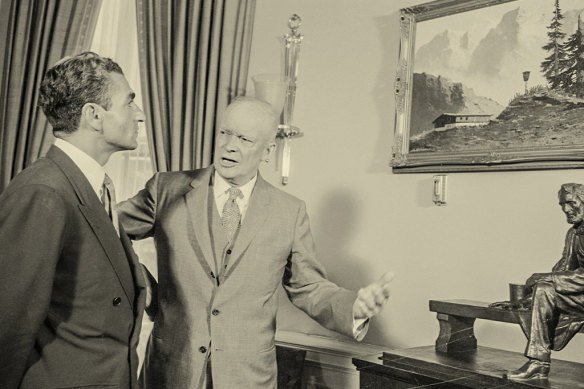
President Eisenhower with the Shah of Iran in the White House in 1958. Credit: Getty Images, digitally tinted
How did Iran become a nuclear nation?
It’s 1953, and United States president Dwight D. Eisenhower is in the thick of an “atomic age” accelerated by Cold War competition. In the eight years since the US dropped atomic bombs on Hiroshima and Nagasaki, the Soviet Union has completed several nuclear weapon tests, as has Britain. “It is not enough to take this weapon out of the hands of the soldiers,” Eisenhower tells the United Nations in a now-famous speech known as Atoms for Peace. “It must be put into the hands of those who will know how to strip its military casing and adapt it to the arts of peace.”
His solution is to encourage countries around the world, including Iran, Pakistan, India and Brazil, to develop their own nuclear energy and research programs. “The US actually co-operated directly with the Iranians in the ’50s,” says Benjamin Zala, a nuclear weapons researcher at ANU. “There were some critics of the Atoms for Peace program at the time saying, ‘You’re opening Pandora’s box here.’ But on the US side, in general, this was seen as something that could be controlled.” In 1968, Iran signed the Non-Proliferation Treaty along with most other countries, pledging to use nuclear technology for peaceful purposes.
Iran, a monarchy under the Shah in 1974, flush with oil money yet envisaging a world where oil could one day run out, approved plans for up to 23 nuclear power stations. It struck deals with German and French companies to begin construction, including on today’s Bushehr plant, south of Tehran on the Persian Gulf. But after the 1979 revolution, which saw the Shah exiled, Supreme Leader Ayatollah Ruhollah Khomeini was initially opposed to nuclear power and the plans were scrapped. The revolution, meanwhile, posed a challenge to the status quo in neighbouring Iraq and triggered it to invade Iran, leading to nearly a decade of war.
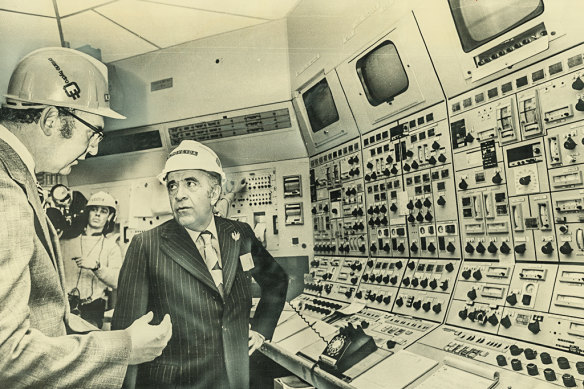
Iran’s then prime minister Amir Abbas Hoveyda visits a nuclear power station in Canada in 1974.Credit: Getty Images, digitally tinted
Iran’s program largely stayed on hiatus during the Iran-Iraq War. Then, in 1995, Russia agreed to complete the Bushehr plant – but US officials caught wind that it had also secretly offered Iran facilities that could enhance its capacity to produce weapons. Under pressure from the US, Russia scaled back its nuclear co-operation with Iran, but US officials believe it still assisted in the construction of Iran’s heavy water research reactor at Arak (more on this later).
Meanwhile, from the late 1980s, nuclear physicist Abdul Qadeer Khan, known as the father of Pakistan’s atomic weapons program, used a global web of scientists, front companies and factories to transfer European and Chinese nuclear technology to would-be nuclear states, including Iran, North Korea and Libya. The International Atomic Energy Agency (IAEA), set up by the United Nations, found in 2003 that Iran had advanced machinery used to enrich uranium that was based on designs supplied by a “foreign intermediary in 1989”.
Khan’s network was exposed in 2003 when intelligence agencies the CIA and MI6 worked together to seize cargo being shipped from Malaysia to Libya and found parts for making machines to enrich uranium. Months later, Khan was dismissed from his official role in the Pakistan government and appeared on television to confess that he had gone rogue. The Pakistan government said Khan admitted he had given technology to Iran. (Pakistan’s prime minister at the time, Pervez Musharraf, pardoned Khan, who died from COVID complications in 2021 and received a state funeral.)
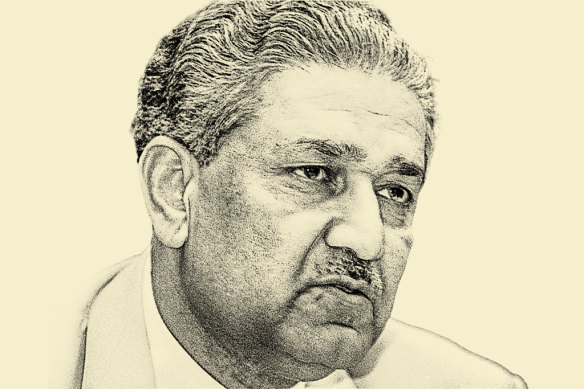
Scientist Adbul Qadeer Khan.Credit: Getty Images, digitally tinted
Exactly when and what triggered Iran’s apparent slide from research into weapons exploration remains unclear. “It’s often a fine line. The Iranians, like other countries, have just developed their nuclear science in a very broad way,” says Trevor Findlay, a nuclear disarmament specialist and honorary professor at the University of Melbourne. Generally, the threat of nuclear weapons in the hands of neighbours and the US is thought to be the motivation. Pakistan has nuclear weapons and it is broadly understood that Israel does too, although it had never declared so.
‘Iran tried to hide nuclear activities before 2003 when its secret uranium enrichment program and other activities were discovered.’
What’s clear is that between the late 1990s and 2003, Iran’s nuclear program did have “possible military dimensions”, according to a landmark report released by the International Atomic Energy Agency several years later. It found Iran tried to procure materials and equipment that suggested military purposes, set up undeclared pathways for nuclear material production, acquired information from a clandestine supply network, and worked towards an “indigenous design of a nuclear weapon”.
“Briefly,” says John Carlson, an international authority on nuclear non-proliferation, “Iran tried to hide nuclear activities before 2003 when its secret uranium enrichment program and other activities were discovered. Since then, while trying to hide aspects of the past, it has complied with basic safeguards obligations but has been evasive at the margins.”
Around 2003, Iran appears to have shelved its program. Experts have two theories as to why. One school of thought, says Zala, is that after the US invaded Iraq in 2003, Iran calculated their weapons research, although not advanced enough to build a bomb, could be discovered, and they stopped it. The other theory goes that Iran watched on as the US campaign to find Iraqi weapons of mass destruction and overthrow Saddam Hussein struggled to meet its aims and dragged on. “The motivation for the program is less,” Zala says, because the US is “utterly bogged down”.
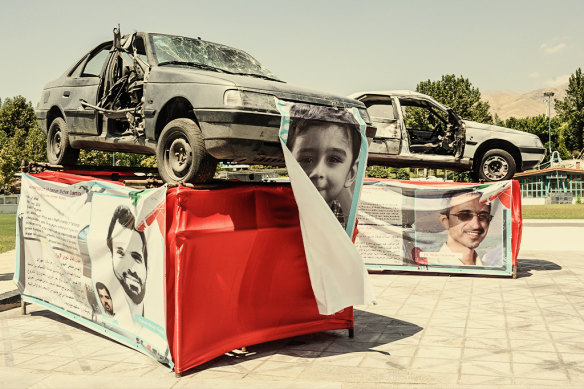
The cars in which scientists were assassinated are exhibited in Tehran in 2012.Credit: Getty Images, digitally tinted
Why were Iranian scientists assassinated?
In Tehran, the scenes have been on public display. In 2012, at the Non-Aligned Movement Summit, the wreckage of cars in which Iranian scientists were assassinated sat on podiums. The cars have also been on show at the city’s Museum of Holy Defence and the Promotion of Resistance Culture, where exhibits display the names of “nuclear martyrs”. On the city’s northern outskirts, the grave of one scientist at the Imamzadeh Saleh shrine is a place of pilgrimage.
In 2010, physicist Massoud Ali-Mohammadi died when a motorbike rigged with explosives detonated as he left his home in Tehran. Days later, Iranian police arrested a 24-year-old who confessed to killing the professor on behalf of Mossad, Israel’s intelligence agency. Later that year, a scientist at Iran’s main atomic energy government agency, Majid Shahriari, died after motorbike riders drove past his car and attached a bomb to the window (that day, another scientist survived attackers using the same modus operandi, which Iranian investigators believe carries the hallmarks of Mossad).
In 2011, gunmen on motorcycles shot dead Darioush Rezaeinejad, whose role as a nuclear scientist is disputed, outside his home, wounding his wife. In 2012, another incident involving a motorbike rider attaching a bomb to a car window killed scientist Mostafa Ahmadi Roshan, who was a department supervisor at the Natanz nuclear enrichment plant, about 225 kilometres south of Tehran.
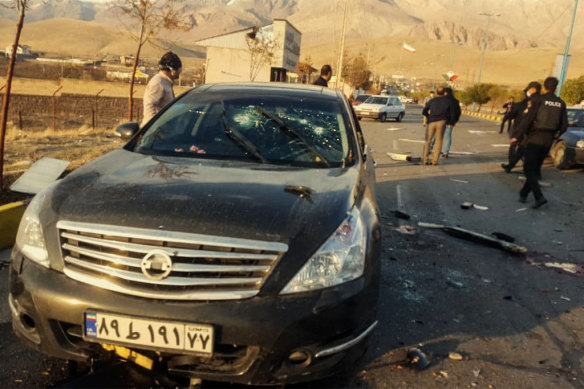
The car that Iran’s top nuclear scientist, Mohsen Fakhrizadeh, was driving before he was assassinated, east of Tehran, in 2020. Credit: AP
Then, in 2020, Iran’s top nuclear scientist, Mohsen Fakhrizadeh, was killed as he drove in a convoy with bodyguards from his vacation home on the Caspian Sea to his country house in Absard. He was shot dead by an AI-assisted machine gun operated by Mossad via satellite, according to The New York Times. His wife, who was in the passenger seat, survived.
These assassinations go much further than Israel simply eliminating Iranian nuclear knowledge, Zala says. “You’re killing the most senior scientist on the program and putting the program back, but you’re also sending a signal to the other Iranian nuclear scientists that, you know, this job isn’t very good for your health.” Iran, for its part, executed one of its own scientists, Shahram Amiri, in 2009 after he provided the US with information about the country’s nuclear program.
Sabotage hasn’t always involved bloodshed. In 2007, US and Israeli intelligence and military agencies used a cyberattack known as Stuxnet to target Iran’s nuclear enrichment facilities at the Natanz plant. The worm took over the operation of some centrifuge machines that isolate the uranium isotope U-235, needed to build weapons, and caused them to break down, designing the attacks to appear like the equipment was malfunctioning.
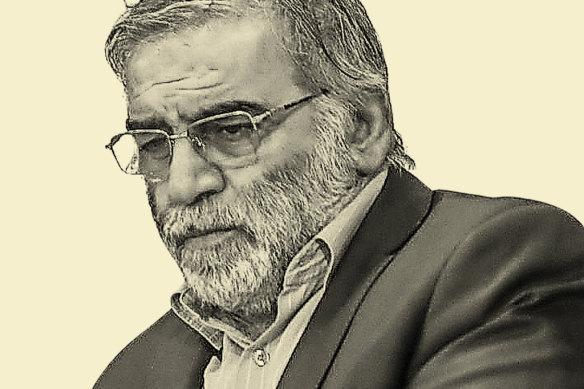
Nuclear scientist Mohsen Fakhrizadeh.Credit: Iranian Leader Press Office, digitally tinted
What is the so-called Iran nuclear deal?
In the decade or so after it seemed to shelve its nuclear program, Iran played cat and mouse with Western inspectors, allowing access to some of its facilities, hiding others, and simply playing dumb when it needed to.
Russell Leslie has first-hand experience of Iran’s approach. A physicist who lectures at ANU, for much of his career Leslie was a nuclear inspector, both for the IAEA and the Australian government. In 2004, he visited a nuclear research facility in Tehran, a friendly bilateral visit ostensibly to help the Iranians rectify “irregularities” in the reporting of their inventory of nuclear materials, which they put down to human error.
“Competence is not the overriding impression you get from dealing with Iranian officials,” Leslie tells us today. “Dealing with the Iranians was very, very odd … sometimes when you’re dealing with people, you realise you’re not dealing with the ‘A’ team from the organisation. Iran has produced some brilliant scientists but commonly, when dealing with the Iranian officials, you got the impression you were dealing with the C team, not even the B team. You were dealing with a C team or worse.”
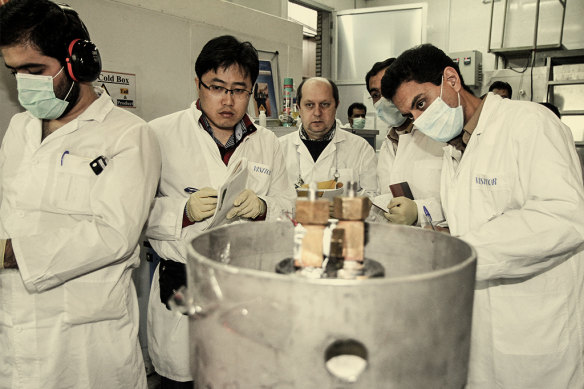
Weapons inspectors from the International Atomic Energy Agency at Iran’s Natanz facility, ahead of an agreement to reduce uranium enrichment, in 2014. Credit: AP, digitally tinted
Flash forward to 2015, and a major breakthrough. After decades spent trying to force Iran to wind down its nuclear weapons research program through trade sanctions and international censure, six nations signed Iran to a new agreement that would provide for much greater scrutiny than the existing protocols and safeguards.
It was certainly a watershed moment and, at least initially, Iran seemed to be holding up its end of the bargain.
Under the Joint Comprehensive Plan of Action (known as the “Iran nuclear deal”), Iran pledged to dramatically curtail its nuclear program, vastly reduce its stockpile of nuclear materials and allow international inspectors almost free rein to monitor its research activities. In return, the United States and partner nations Britain, France, China, Russia and Germany would begin lifting the sanctions that had led to crippling shortages of essential items and to hyperinflation – and Iran could embark on its rehabilitation as a responsible and diplomatically co-operative citizen of the world.
“We have cut off every pathway for Iran to develop a nuclear weapon,” US president Barack Obama declared. Whether it signalled a new relationship between the United States and Iran remained a bigger question. But it was certainly a watershed moment, and, at least initially, Iran seemed to be holding up its end of the bargain.
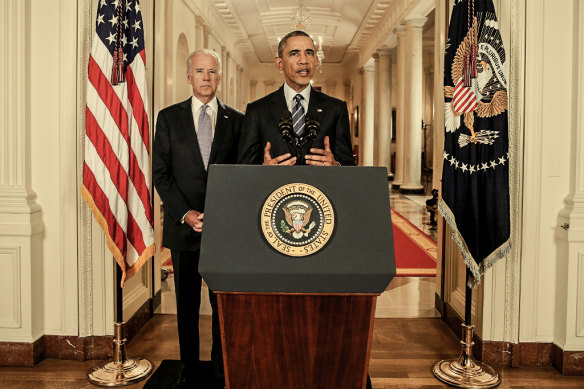
President Barack Obama, flanked by then vice-president Joe Biden, in the White House after an Iran nuclear deal was reached, in July 2015.Credit: Getty Images, digitally tinted
“It was a breakthrough in that the Iranians, for the first time, had agreed to cap their ambitions,” says Trevor Findlay. In January 2016, the IAEA confirmed that Iran had already shipped more than 10 tonnes of enriched uranium out of the country, dismantled most of the centrifuge machines necessary to enrich batches of uranium, and agreed to fill in the core of one reactor with concrete. Post-deal, said Obama, Iran had gone from possibly being able to build nuclear weapons within weeks or months to taking at least a year, which appeared to be an acceptable compromise.
‘It was a great shame because it was an international agreement that was actually working.’
Then came Donald Trump, sworn in as US president in early 2017. The Republicans had always been sceptical of the Obama deal, arguing, along with Israel, that some of its loopholes had been too lenient on Iran. In mid-2018, Trump, encouraged by a long-running anti-Iran campaign by Israeli Prime Minister Benjamin Netanyahu, announced he was withdrawing the US from the deal. The agreement, Trump said, was “a horrible one-sided deal that should have never, ever been made”.
When the US backed out, the deal incrementally began to fall apart, even though Iran and the other five nations remain signed on. Says Findlay: “It was just [Trump’s] projection of being a strongman, just casting these multilateral diplomatic agreements aside and thinking that it’s all about threats. There were a whole lot of factors that fed into that, but it was a great shame because it was an international agreement that was actually working.” Iran became less and less co-operative with nuclear inspectors, reverting to its patterns of obfuscation and denial.
“The decision to withdraw from the nuclear deal, which Iran was complying with, both removed the guardrails on Iran’s nuclear program and removed any incentive for Iran to move in any direction other than a more confrontational, harder line,” Benjamin J. Rhodes, a deputy national security adviser in the Obama administration, told The New York Times this week.

Donald Trump announces the United States’ withdrawal from the Iran nuclear deal in 2018.Credit: Getty Images, digitally tinted
By 2022, according to the IAEA, Iran had restricted access to inspectors to such an extent it had “seriously affected” monitoring of aspects of its nuclear program, including “activities which could contribute to the design and development of a nuclear explosive device”.
According to Darya Dolzikova, a research fellow in proliferation and nuclear policy at the Royal United Services Institute in London, the IAEA is not currently conducting monitoring and verification activities at Iran’s uranium mines and mills or at its centrifuge production facilities. However, she tells us from London, “The CIA director has recently stated that he expects that the US and its allies will be able to detect a decision to weaponise fairly early on – which is reassuring.”
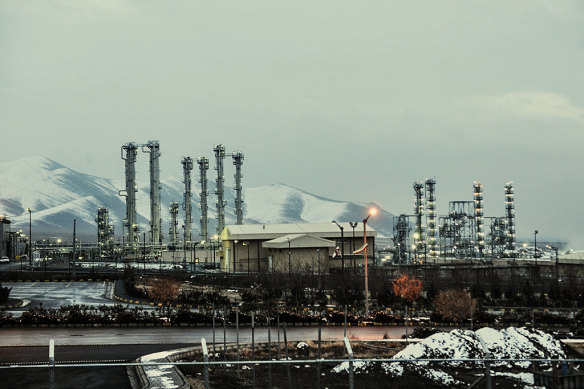
Iran’s heavy water nuclear facility near Arak. south-west of Tehran in 2011, before the Iran nuclear deal was signed. Credit: Getty Images, digitally tinted
What is Iran’s nuclear capacity today, as far as we know?
With Iran limiting inspectors’ access to much of its program, we are increasingly left in the dark about its abilities and the extent of its stockpiles of uranium. What we do know is Iran has a single commercial nuclear plant that makes electricity, at Bushehr, which uses fuel supplied by Russia. We know it has several sites, including facilities where it runs the centrifuge machines necessary to isolate the weapon ingredient U-235 from the much more common isotope U-238. (Isotopes are atoms of the same element that differ only in their numbers of neutrons; uranium 235 is the only uranium isotope that can undergo fission when the nucleus breaks apart and generates enormous amounts of energy.)
Iran’s major facilities are at Fordow, dug into a mountain near Tehran; an unfinished reactor at Khondab; a vast underground enrichment plant at Natanz; and the centre at Isfahan, Iran’s second-largest city, believed to employ some 3000 scientists. The heavy water reactor at Arak, meanwhile, is believed to have been decommissioned after its core was filled with concrete. Heavy water reactors use coolant water made from the hydrogen isotope deuterium rather than common hydrogen, and they produce plutonium, a byproduct of the reaction process, more manageably than light-water reactors.
Plutonium is commonly used in contemporary nuclear weapons because it can be used in much smaller quantities than enriched uranium for comparable payloads, making it more practical for missiles, where the core might weigh just a few kilograms. Iran likely has small amounts of plutonium from laboratory experiments; otherwise, its nuclear stockpile is believed to be composed almost entirely of refined uranium.
We know, from IAEA inspections, that Iran has enough uranium that has been enriched close to what experts call “weapons-grade” to form the cores of a handful of weapons, with the final enrichment process only a matter of weeks. “We are much closer to Iran weaponising than, say, a few years back,” says Anisheh Bassiri Tabrizi, an analyst at Control Risks and associate fellow for Chatham House.
Recent reports have focused on what experts call “nuclear breakout”, the amount of time needed to manufacture enough material to fuel a nuclear bomb. In August, the Institute for Science and International Security think tank in Washington claimed that Iran was at the point where it could “break out quickly, in days”. However, that’s just one part of the process of making a viable weapon.
“We know how much enriched uranium Iran has, and analysts have, from that, been able to draw estimates on how quickly Iran could enrich sufficient weapons-grade uranium for a single weapon,” says Darya Dolzikova. “However, we don’t know, at least in the public domain, how long it might take Iran to actually build a nuclear weapon, should it decide to do so.”
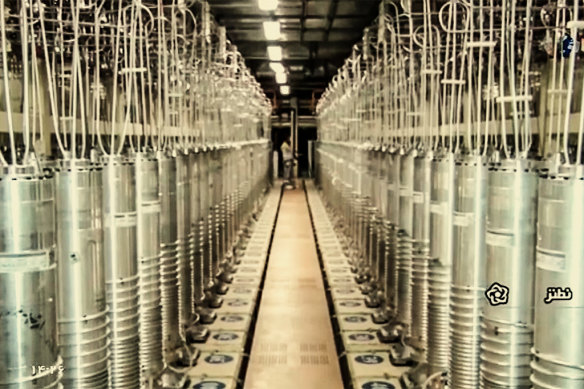
Centrifuge machines at the Natanz uranium facility in 2021. Credit: Video still, Islamic Republic Iran Broadcasting, digitally tinted
Making weapons from a uranium stockpile is an involved process. The World War II Manhattan Project, for example, in which the US made the nuclear bombs that were dropped on Japan, employed about 160,000 people and cost around $50 billion n today’s dollars. “That was really hard to do and required really clever, technically competent people,” says Russell Leslie. While the science is now well understood, there is no side-stepping much of the engineering prowess required. Even if Iran is capable of making a crude bomb, it faces enormous engineering challenges in miniaturising the components into a modern warhead sufficiently robust to fit into a missile and explode on target.
As David Albright writes for the Institute for Science and International Security: “It involves theoretical calculations and simulations; development, testing, and construction of the other components of the nuclear weapon; the conversion of weapon-grade uranium into metallic components; the integration of all the components into a nuclear weapon; and the preparation for mounting the weapons on aircraft or missiles or for use in a full-scale underground test.” It’s more likely, he writes, that “an Iranian accelerated program would not aim to produce warheads for ballistic missiles, a task that could take significantly longer than six months. Nonetheless, a crude nuclear weapon would signal Iran’s entry into the nuclear weapons club.”
It’s also a matter for debate whether Iran even wants to possess live atomic weapons.
The IAEA believes that Iran “does not yet have a viable nuclear weapon design or a suitable explosive detonation system”. It’s also a matter for debate whether Iran even wants to possess live atomic weapons, says John Carlson. Iran has always denied having a nuclear weapons program, though there have been occasional slips: according to Reuters, Supreme Leader Ali Khamenei has said that if Iran wanted to build nukes, world leaders “wouldn’t be able to stop us”.
Loading
Carlson argues Tehran might be focused on what he calls “nuclear latency” – the ability to produce nuclear weapons if it wanted to. “Iran sees nuclear latency as a major deterrent against others in the region, such as Saudi Arabia, pursuing nuclear weapons,” says Carlson. (Saudi Arabia does not currently have a nuclear energy program. Then again, Crown Prince Mohammed bin Salman said in 2023 that Iran gets a nuclear weapon, “we have to get one”.) “Basically, Iran wants to be accepted in the international community as a leading player; it does not want to be a pariah state. It knows if it pursues nuclear weapons, in addition to the likelihood of Israeli and US intervention, it will be even more isolated.” But, he warns, “The problem is, if Iran believes current sanctions will never be lifted, and hostile action against it is likely in any case, it may feel pushed into going nuclear.”
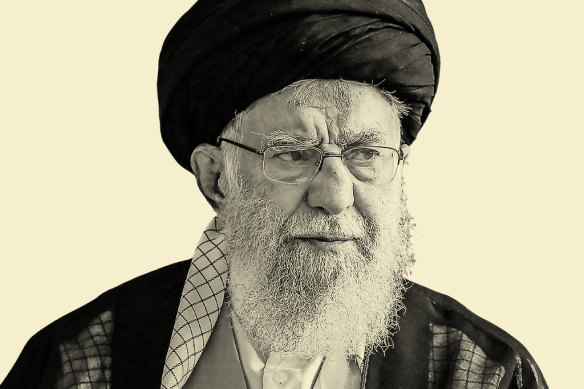
Iran’s Supreme Leader Ayatollah Ali Khamenei.Credit: Iranian Leader’s Press Office, digitally tinted
Could Israel degrade Iran’s program through air attacks?
It would be difficult, say the experts we spoke with. “At this point,” says Dolzikova, “getting rid of the Iranian nuclear programme definitively is nearly impossible because the expertise to rebuild whatever may be destroyed through sabotage or strikes already exists. Rolling it back significantly through military means would also be difficult because sites are spread out across the country, and some of the facilities are underground. As for secret sites, it’s hard to assess what we don’t know. Any large facilities would likely be identifiable through satellite imagery, but it is technically possible that there may be small facilities related to the Iranian nuclear programme that have not been identified by the IAEA or the wider international community.”
Israel already has a historical precedent. In 2007, it struck a nuclear reactor in Syria that Netanyahu acknowledged years later was “to prevent our enemies from arming themselves with nuclear weapons”. Even earlier, in 1981, during the Iraq-Iran war, Israel took an opportunity to destroy Iraq’s nuclear research centre at Tuwaitha, where it suspected it had the capability to produce weapons-grade material. “Advocates of doing it again in Iran today will tell you it worked really well,” says Benjamin Zala. “There’s a grain of truth to that, but what it definitely did was make the Iraqis double down.”

In Israel, children pose for a photo in front of a missile following attacks by Iran on October 1. Credit: Getty Images, digitally tinted
Israelis have debated for more than a decade the potential for a strike on Iran’s facilities. In 2012, faced with ongoing ambiguity around the capacity of Iran’s nuclear program, Netanyahu told the UN that the hour was getting “very late”.
Loading
“The relevant question is not when Iran will get the bomb. The relevant question is at what stage can we no longer stop Iran from getting the bomb,” he said. “The red line must be drawn on Iran’s nuclear enrichment programme because these enrichment facilities are the only nuclear installations that we can definitely see and credibly target.”
Last week, President Joe Biden discouraged Israel from bombing Iranian oil fields in retaliation against Iran’s recent strikes, and said he would not support Israel targeting Iranian nuclear sites. Israel is more likely to hit Iranian military installations such as those used to make and launch missiles, analysts believe. “A possible strike would also be significantly more escalatory than countries such as the US want,” Anisheh Bassiri Tabrizi tells us from Dubai. “It would entail a significant response, probably in kind from Iran, and also possibly shift the internal debate within Iran towards the need to weaponise its nuclear program.”
Trevor Findlay agrees a hit to nuclear sites would be unlikely to achieve the outcome that Israel desires. “The Iranian program is quite large and spread out in different facilities, so it wouldn’t bring a permanent end to the program,” he says. “But essentially, the Iranians know how to build a bomb, and you can’t bomb the knowledge out of existence.”
Get fascinating insights and explanations on the world’s most perplexing topics. Sign up for our weekly Explainer newsletter.



























